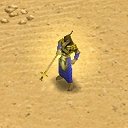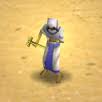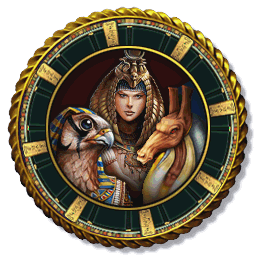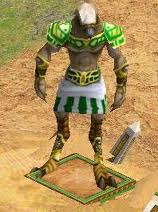BroccoliBot (talk | contribs) m (→Heroes: clean up, replaced: [[Human Units (Age of Mythology)| → [[Human unit|) |
BroccoliBot (talk | contribs) m (→References: clean up, replaced: Category:African Civilizations → category:African civilizations) |
||
| Line 119: | Line 119: | ||
[[Category:Age of Mythology]] |
[[Category:Age of Mythology]] |
||
[[Category:Egyptians]] |
[[Category:Egyptians]] |
||
| − | [[Category:African |
+ | [[Category:African civilizations]] |
[[Category:Middle Eastern Civilizations]] |
[[Category:Middle Eastern Civilizations]] |
||
Revision as of 16:10, 19 February 2018
| This article is about the civilization in Age of Mythology. For their appearance in Age of Empires, see Egyptians (Age of Empires). |
The Egyptians are a culture in Age of Mythology.
Gods
Major Gods
Classical Age Gods
Heroic Age Gods
Mythic Age Gods
Resource Gathering
Laborers, the Egyptian workers, are slower at gathering resources than other cultures' workers. This can be offset by having the Pharaoh (or with Ra, Priests) empower the relevant drop-off building. In contrast to the other cultures, the Egyptians have separate drop-off buildings for food, wood and gold; they are all built slowly though they are free.
Heroes
Unlike the Norse and Greeks, the Egyptian hero is not simply a regular unit with an attack bonus against myth units. Instead the Egyptians have the Pharaoh, a hero that heals and is devastating against Myth Units, and Priests, which are essentially lesser versions of the Pharaoh. The Egyptian player starts with a Pharaoh and a Priest. Priests are fairly expensive and rather weak against human soldiers.
Pharaoh

- Main article: Pharaoh
The Pharaoh is a fairly tough warrior, but is still no match for grouped human units. However, he is a powerful support unit due to his strong attacks against enemy Myth units and his ability to heal. Set's Pharaoh can also summon animals.
If killed, the Pharaoh regenerates at the player's starting Town Center after one and a half minutes, so he is never out of action for long.
Son of Osiris

Using the Son of Osiris god power (supplied, unsurprisingly, by Osiris), the Pharaoh can be turned into a falcon-headed demigod. He still has all of the Pharaoh's abilities, but is vastly more powerful in combat. The Son of Osiris has increased armor, many more hit points and a powerful, chain-lighting attack that can hit up to four targets at once. However, he cannot be healed, and if killed, a normal Pharaoh will appear in its stead.
Priest

- Main article: Priest (Age of Mythology)
Like the Pharaoh, the Priest has a ranged attack with a large attack bonus against mythological units, but is very weak against regular units. It can also heal units. The Priest has the additional ability to summon obelisks, which are cheap and quickly placed structures that provide a large line of sight. Priests can be trained at the Town Center (once a Temple has been built) or at the Temple. All three major gods have a bonus to their priests - Ra's can empower buildings like the Pharaoh, Isis' place obelisks faster and at lower cost, and Set's can convert wild animals to serve the player.
Favor
The Egyptian player gains Favor by building five different Monuments to the glory of their chosen god. Each of these monuments generates favor at a set rate. Once the monuments are built, this method of gaining favor doesn't require any management. Though it is not as easy to regulate as the Greeks' method (putting more villagers on the Temple), empowering monuments can increase the total favor coming in a little.
Titan (The Titans expansion only)
The Titan available for the Egyptians is the God Horus.
Starting Conditions
Each of Age of Mythology's cultures has different starting conditions in a normal game. The Egyptians start with a Pharaoh, a Priest, and two Laborers. The Priest is typically used to scout and the Pharaoh to empower the Town Center or wherever Laborers are gathering resources.
Language (Ancient Egyptian)
- Antio/intoyou
- You-a-ear
- Hayoh/ taiyoh/ taeyu - Good / Well
- Ark
- Aerifear
- Eel-you-refer
- Hroengyawet (M) Hroeyatawit (f) - wood
- Endwege/inwedge
- Gerrick/geregg/grikk
- Baya (f) Beiya (m) - mine
- Nitu
- Eya ackjiu - attack
- Ackjiu - attack
- Eya air erracter - attack
- Enejereek - I am king
- Heisora - animal of Set
- Edowa - animal of Set
- Hahiru - animal of Set
- Nu - hunter
- Naya insurhret (f) nayendesshret (m) - forage
Trivia
Greg "DeathShrimp" Street, one of the designers of Age of Mythology, came up with most of the lines based on what he could "scrape together off the early 2000s internet". If one of the lines sounded "too goofy", they would change it during recording, as they considered entertainment value more important than historical accuracy.[1]
AI Player Names
All Versions
Vanilla and the Extended Edition
These names only appear on AI players following the Big Boomer or the Aggressive Rusher AI.
Vanilla Only
These names only appear on AI players following the Balanced or the Vanilla Random AI.
Trivia
- The Egyptians of Age of Mythology draw notable influence from Hellenistic Egypt (when the Ptolemaic dynasty ruled), evident from the presence of Catapults, the Lighthouse and War Elephants.
- Three of their Myth Units refer to other Afro-Asiatic peoples; the Roc (drawn from Arabian mythology), Leviathan (drawn from Hebrew mythology, in turn of Phoenician/Canaanite influence) and the Scorpion Man (drawn from Mesopotamian mythology).
- Also, thanks to their Barracks units (who represent generic Bronze Age troops, armed with epsilon axes, spears and slings), and the Chariot Archer and Camelry units, they can be used to represent some of the above mentioned peoples.
Template:Culture


